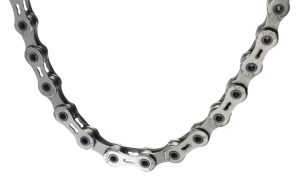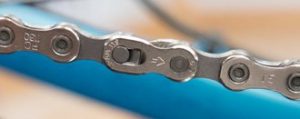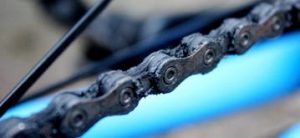Bicycle Chains – Which is Best?
 This article was originally written in 2007 and appeared in Triathlete Magazine. It has been updated as of October 2018 to reflect current trends and technology in the space.
This article was originally written in 2007 and appeared in Triathlete Magazine. It has been updated as of October 2018 to reflect current trends and technology in the space.
I’ve received conflicting recommendations as to what chain brand to use and why. Are there any meaningful differences between chains and does the chain you use really matter? -Sean , TN
Sean,
A bike is a sum of its parts and it only takes one of those parts not interacting well with the others for the bike not to work well. Your chain is at the heart of your drivetrain and is absolutely crucial to powering your bike forward and to shifting performance. Therefore, with chains, compatibility and durability are a must and mechanical serviceability and even mechanical friction are considerations as well. In other words, what chain you use can matter.
Chain Compatibility – 10 Speed:
One would think that chain compatibility would be as simple as finding a chain that is made for the same number of gears you have on your rear cassette. There was a time when that was pretty  much true. However, with the advent of the 10 speed drivetrain, tolerances and spacing became so tight that chains become more brand specific. As an example, Shimano and SRAM ten speed compatible chains tend to be very close to 5.9mm wide while Campagnolo 10 speed compatible chains are a little wider at 6.1mm. While 0.2mm is a pretty small number, it can be a meaningful number. At certain chain angles, if your chain is too wide or too narrow for the drive train it is being used on, the likelihood of the chain catching on the other teeth in the drivetrain and creating skipping, noise or inconsistent operation will be higher.
much true. However, with the advent of the 10 speed drivetrain, tolerances and spacing became so tight that chains become more brand specific. As an example, Shimano and SRAM ten speed compatible chains tend to be very close to 5.9mm wide while Campagnolo 10 speed compatible chains are a little wider at 6.1mm. While 0.2mm is a pretty small number, it can be a meaningful number. At certain chain angles, if your chain is too wide or too narrow for the drive train it is being used on, the likelihood of the chain catching on the other teeth in the drivetrain and creating skipping, noise or inconsistent operation will be higher.
If you want to guarantee the best compatibility, you should keep the brand of chain the same as that of your derailleurs and shift levers. Components within a brand are designed as a system to work best together. This being said, as long as dimensions are very similar to each other, chain brands are usually interchangeable and some brands may have advantages (see “serviceability” below) worth considering. SRAM 10 speed chains share the same width as Shimano, and therefore usually work interchangeably. Wippermann makes two widths of their Connex chains with “S” labeled models (10SO, for example) being designed to be compatible with Shimano and non-S series (1008, for example) chains being designed to work with Campagnolo.
(Tech Update: As of 9/07, all common 10 speed chains measure between 5.95mm and 6.1mm and should be universally compatible between brands. Some Wippermann Connex links interfere with some 11 tooth lockrings, but Wippermann is now only producing “S” chain models and all are universal to SRAM, Shimano or Campagnolo.)
Chain Compatibility – 11 and 12 Speed:
Bucking the norm, functional compatibility between brands actually improved with the introduction of 11 speed cassettes. Why? In its simplest term, the manufacturers ran out of room to use their own slightly unique dimensions and thus chain dimensions became more similar across brands. 11 speed drivetrains resulted in outer cage plate dimensions on chains becoming narrower, but the inner dimensions changed little. For this reason, you can use most 11 speed chains on a 10 speed drivetrain. However, it doesn’t work the other way. A 10 speed chain’s wider outer width will not fit well between 11 tooth cogs. 12 speed chains are specific to 12 speed drivetrains and 1x drivetrains often have their own chains.
With 11 and 12 speed, we continue recommending that you stick with drivetrain manufacturer’s chains if you want the best performance. This being said, with 11 speed drivetrains, Shimano and SRAM often work pretty well together and many aftermarket chains from companies like KMC (who makes a lot of Shimano’s chains) are fine substitutes.
Chain Durability:
The old adage of a chain only being as strong as its weakest link is true; all it takes is one pin or link to fail and your bike will come to a stop in a hurry. Usually, this weakest link is the chain’s
master link or pin, which can sometimes be compromised at installation or simply may not be as strong as the permanent links surrounding it. All of the chains from the established builders are reliable; however, if you have to pick a weakest link, the master pins that Shimano chains used for decades seem to be a bit more finicky than the rest. This being said, Shimano chains shift exceptionally well when used with other Shimano components and the failure rate, when properly installed, is still quite low. More recently, Shimano introduced a true master link like many other  brands to compliment their pin. We like the master link, compared to the pin, on Shimano chains.
brands to compliment their pin. We like the master link, compared to the pin, on Shimano chains.
We have not seen enough of a pattern to establish a huge difference in chain durability across brands. Anecdotally, it seems that some of the stainless steel chains can resist stretching longer than some other materials. However, when it comes to how long the chain lasts, the rider’s maintenance and wear patterns are the biggest variable that affects the stretch and service life of their chain. The cleaner and better lubricated you keep your drivetrain, the longer the chain will last. This being said, I’ve seen powerful riders with dirty chains stretch them to the point of replacement in less than 1000 miles while lighter riders with clean drivetrains can often go above 4000 miles.
Higher quality chains will often use nickel or even stainless steel in their construction to increase resistance to stretching and some models even offer weight saving features like hollow pins. There are even titanium chains from brands like KMC and YBN for those looking for a way to dispose of $200+ on a part that needs replacing regularly.
It is worth noting that going a notch up the component spectrum on a chain frequently gets you better quality coatings and plating on the chain for a pretty low additional cost. The price difference between a Shimano Ultegra and Dura Ace chain is $10 right now.
Chain Serviceability:
If you use the right lubricants properly, you will potentially only need to remove your chain to replace it; you can keep the chain clean while leaving it on the bike. If this is the case, ease of removal  will not matter much. However, if you like to remove your chain for cleaning or servicing, some chains are easier than others. 11 and 12 speed chains from Shimano and SRAM use master links that both companies suggest be replaced anytime the chain is removed. This being said, we know a number of riders who reuse their SRAM and Shimano master links. Neither company offers a link that can be removed without the use of a basic plier-like chain tool. Campagnolo uses special pins on their 11 and 12 speed chains that require special pin tools and rather pricey pins. “Universal” removable and reusable links and chains, including some tool-free designs, are available in the aftermarket from companies like Wipperman (Connex link), KMC and Taya.
will not matter much. However, if you like to remove your chain for cleaning or servicing, some chains are easier than others. 11 and 12 speed chains from Shimano and SRAM use master links that both companies suggest be replaced anytime the chain is removed. This being said, we know a number of riders who reuse their SRAM and Shimano master links. Neither company offers a link that can be removed without the use of a basic plier-like chain tool. Campagnolo uses special pins on their 11 and 12 speed chains that require special pin tools and rather pricey pins. “Universal” removable and reusable links and chains, including some tool-free designs, are available in the aftermarket from companies like Wipperman (Connex link), KMC and Taya.
Mechanical Chain Friction:
What do mechanical engineers who like to ride bikes do in their spare time? Test things. With this in mind, there is a lot of information available regarding friction differences between dirty drivetrains and clean as well as the differences between different chain brands and lubrication options. The details of this are way beyond the scope of this article. However, some general concepts that most any rider interested in reducing friction in their drivetrain are as follows:
- Clean drivetrains offer the lowest friction. Keeping your drivetrain clean and lubricated with an ultra-low friction lubricant is the number one thing you can do to minimize mechanical
 friction.
friction. - Between the “Big Three” (Shimano, SRAM & Campagnolo), Shimano Dura Ace chains tend to historically test with the lowest friction. It is worth noting that the tests that conclude this often do so after the chain is purged of its OEM coatings and one of the better performing lubricants is used. Regardless, the difference between brands pales in comparison to other factors; the friction difference between units within a chain can be far greater than the difference between brands and models. In other words, choosing a chain brand based on mechanical friction alone can be a crap shoot; other variables are usually worth the thought.
- Ultra-low friction “race” coatings are available from companies like Ceramic Speed. These coatings are designed to last about 150 miles and offer the lowest friction numbers. These factory applied coatings are frequently available on chains from a number of manufacturers. It is worth noting that a new chain’s friction goes down about 0.5 watts after the first hour of use. It is never a good idea to ride a brand new component for the first time on race day – ride your new chain for 20 miles before race day.
- Running a low friction chain lube with a cleaner, (like some Rock n’Roll lubes) and following the application and cleaning instructions is the biggest thing you can do to minimize friction.
The roller chain design used on bicycles has been around for well over one hundred years; its roots can be traced all the way back to DaVinci. Centuries later, no one has come up with a design that transfers human power more efficiently. A modern roller chain is simple and also technical at the same time. The chamfered plates and subtle details that make-up a modern bicycle chain are a significant reason why modern index shifting works so well and why 10, 11 and 12 speed rear cassettes can exist and work so well. As chain technology has evolved, and more brands have entered the market, so has the importance of addressing compatibility with the rest of your components as well as considering how your chain addresses durability, performance and serviceability.
Enjoy the ride and train hard and smart!
Ian
originally published July 2007/Copyright © 2007
